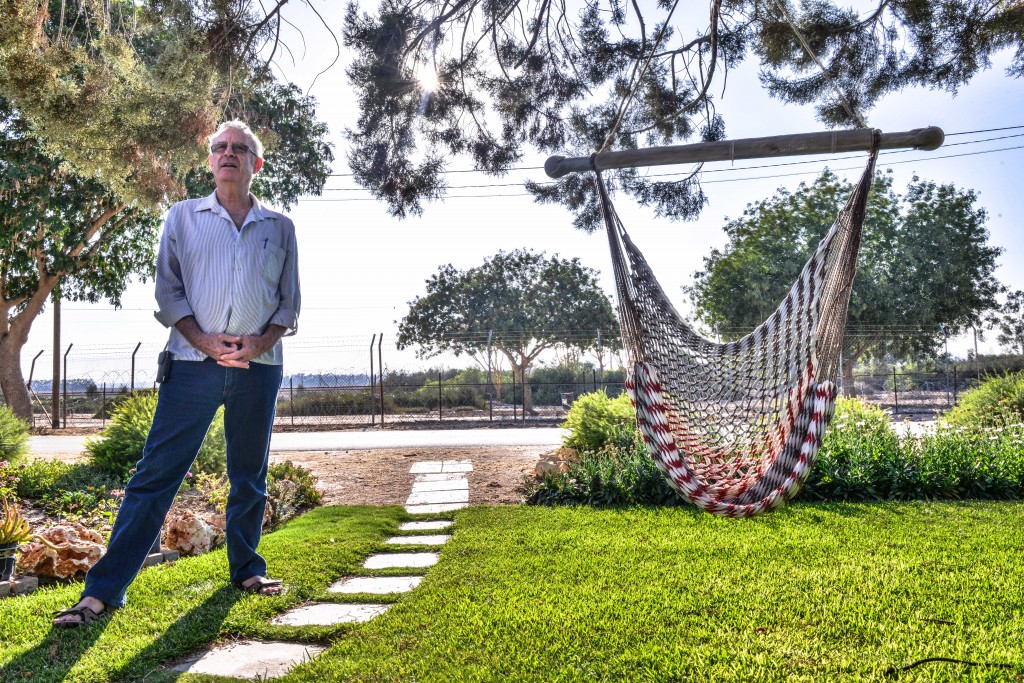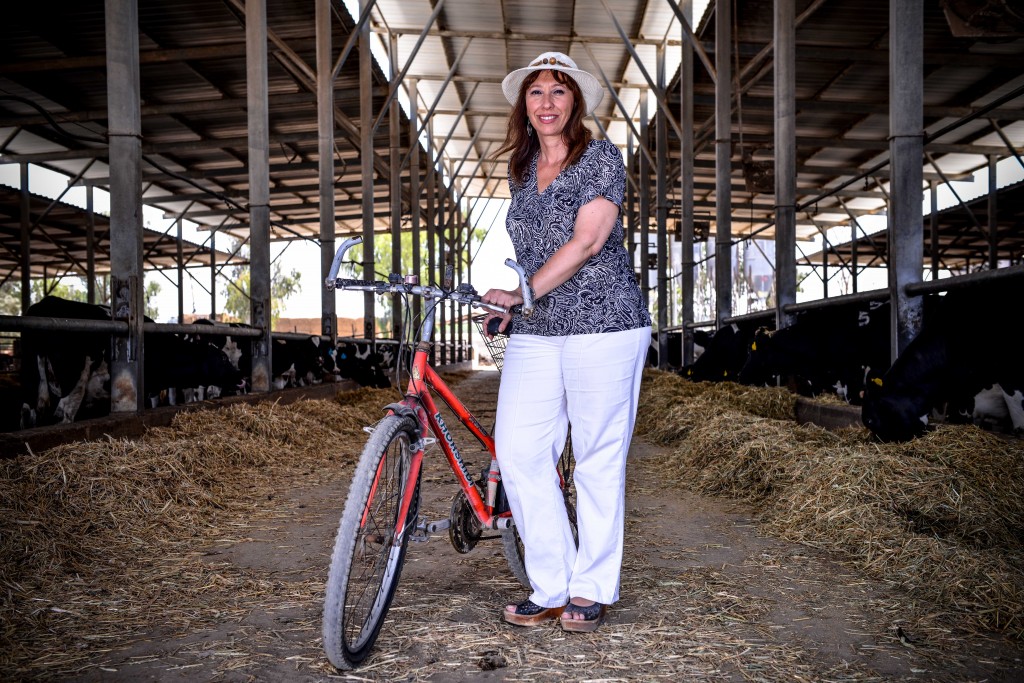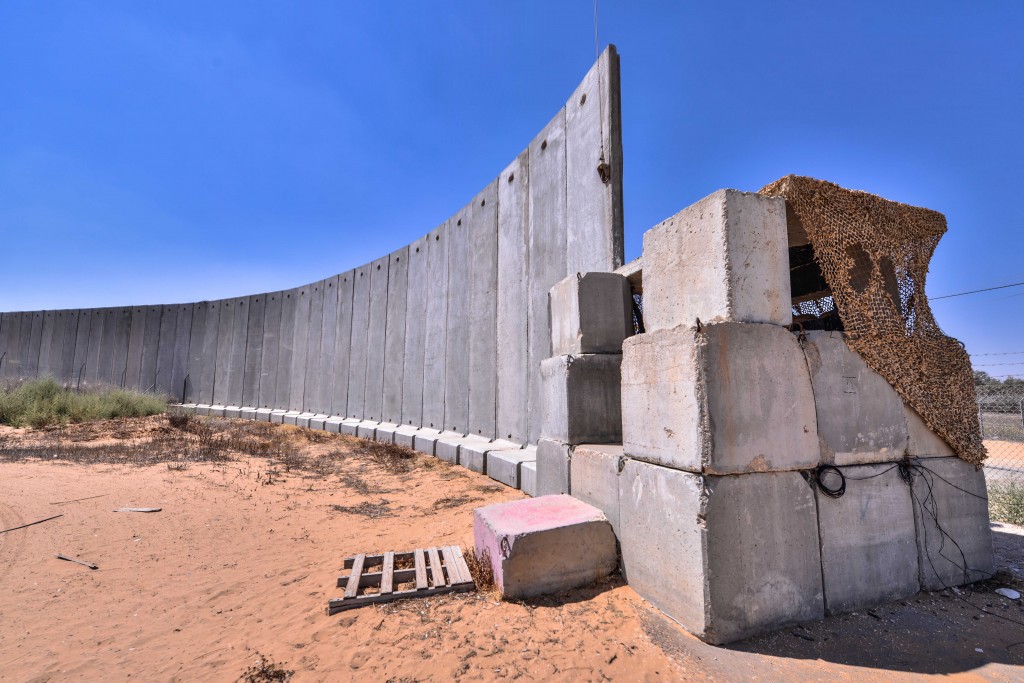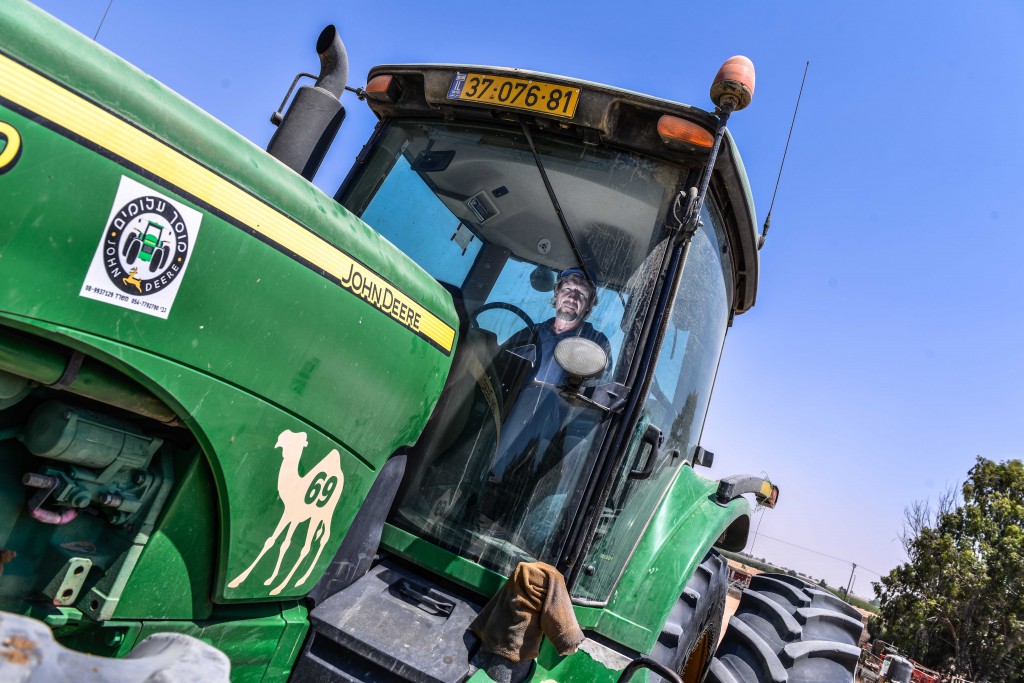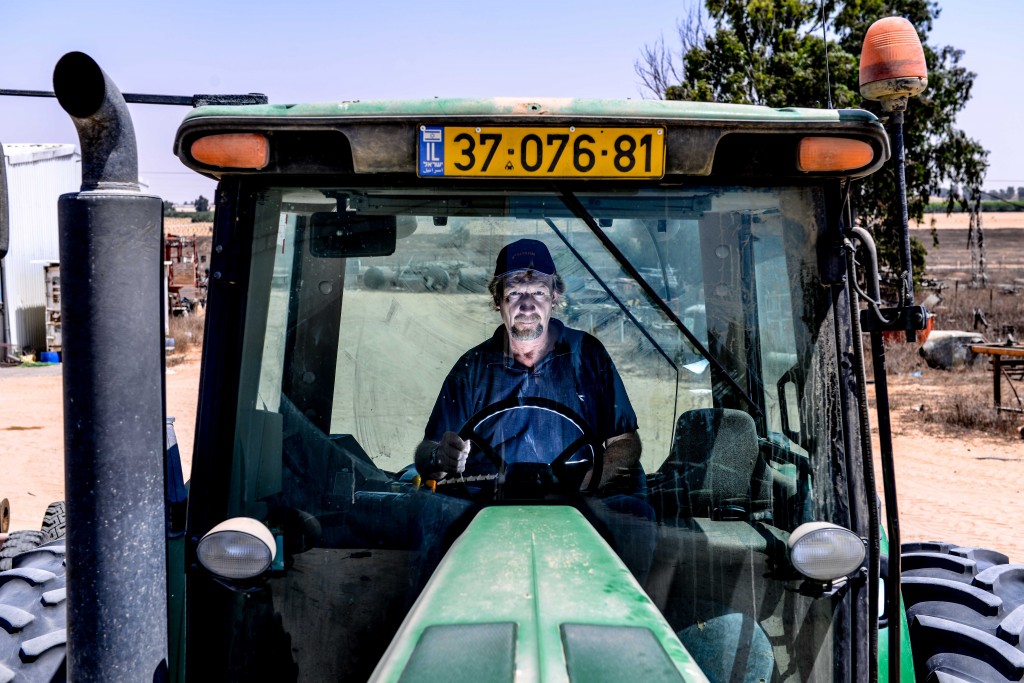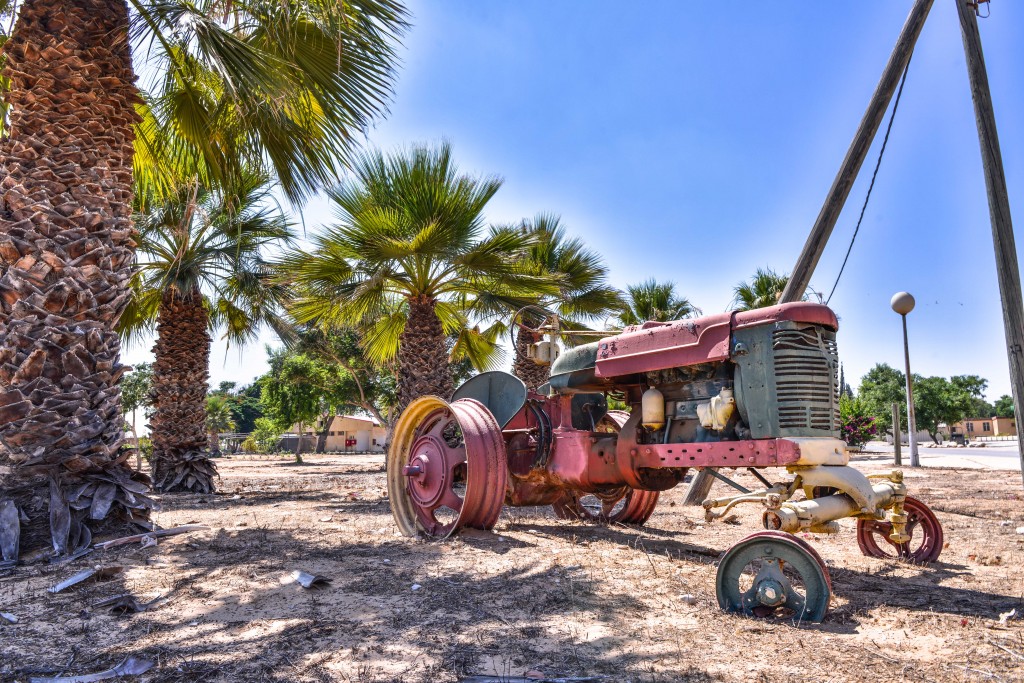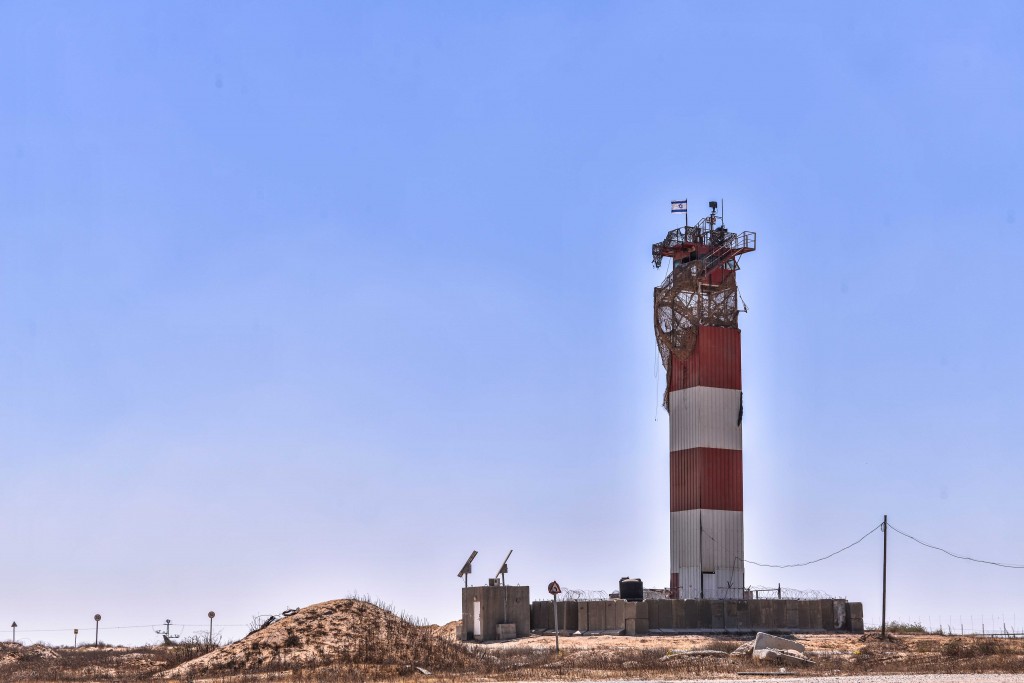The communities of the Eshkol region continue to suffer from daily rocket fire from Gaza. A visit there reveals a mix of patience, long-developing fatigue, ideological questioning and remarkable spiritual resolve.
Everything was quiet until the moment it wasn’t.
On the evening of June 23, 2013, in response to the shooting to death of one of their commanders by a Hamas police officer, Islamic Jihad launched six rockets toward Israel. They fell across the upper Negev region, striking the cities of Rahat, Beersheva, Netivot, and Ashkelon. There were no severe injuries or property damage. To prevent further attacks, the Israeli Air Force struck two missile depots in the Gaza Strip. There was no further escalation. By June 26, Hamas and Islamic Jihad had announced a reconciliation. The region returned to a fragile normalcy.
In November 2012, the Israel Defense Forces undertook Operation Pillar of Defense, a week-long offensive designed to neutralize the threat of rocket attacks from Hamas and other jihadist groups in Gaza. Since then, the number of rocket attacks has decreased significantly. The June 23 attack, as well as one that took place four days earlier, was the first since April 20, 2013. Since the new year, some 25 rockets have been fired from Gaza, with no fatalities or serious injuries reported.
Pillar of Defense temporary lifted the smothering fear of random rocket fire, giving a respite to the residents of Israel’s south and, in particular, the inhabitants of the Eshkol Regional Council. This predominantly agricultural community of 12,500 people living on 14 kibbutzim, 15 moshavim (settlements in which property is not held in common), and two collective settlements is located where the borders of Gaza, Egypt, and Israel intersect. Its farmland is worked right up the border fence. Members of kibbutz Kerem Shalom live as close as 100 yards from the front line, protected from sniper fire by a concrete wall.
“At the moment, it’s quiet,” Eshkol residents often say with satisfaction, but also hope.
The kibbutzim form a chain from the northernmost settlement of Be’eri through Re’im, Kissufim, Ein Hashlosha, Nirim, Nir Oz, Magen, Nir Yitzhak, Sufa, and Holit, ending at Kerem Shalom in the south. Their residents are a jumbled reflection of the history of the region: They include descendents of pioneering immigrants from eastern Europe and South America, former members of IDF Nahal units (a brigade dedicated to founding permanent agricultural settlements) and socialist youth movements, and evacuees from the Rafiah Salient and the Gaza Strip.
The location of these kibbutzim is a product of another time in history: A time of austerity and mass migration, before the construction a well-equipped, highly-trained army, when civilian settlement in the periphery of the new State of Israel was the principal means of establishing borders, defending the land, and absorbing new immigrants. It was also a time when European collectivist ideas of social solidarity and communal living dominated political and intellectual life. When the ideals of the kibbutz were central tenets of the larger Zionist dream.
That time is now over. But at the end of the land where rockets often rain down at random, the pioneers remain.
Shortly before nine o’clock in the morning one Saturday, a rocket landed close to Kibbutz Nir Yitzhak’s children’s farm. Had it landed just one hour later, parents would have been taking their sons and daughters to play with the animals. Had it been any other day of the week, the destruction it would have caused is too terrible to contemplate.
Up and down the border, each kibbutz has its own tale of suffering and sometimes loss: A rocket landed on one of Kibbutz Be’eri’s playgrounds, wounding a 12-year-old girl and another aged only two. In the neighboring settlement of Nir Oz, Amnon Rosenberg—a resident of Kibbutz Nirim—was killed in 2008 when a mortar hit the paint factory. That same year, a volunteer from Ecuador, Carlos Andres Chavez, was murdered by a sniper from the Izz al-Din al-Qassam Brigades while working the land of Kibbutz Ein Hashlosha. Two workers at Kibbutz Kissufim sustained critical injuries when Hamas fired rockets into their chicken house.
Adele Raemer—a member of Nirim and an educator at the regional school near Kibbutz Magen—showed me the scars etched into her village by the rockets. As we drove to her house, we passed the perimeter fence and saw where a rocket had landed during Pillar of Defense, striking the road only yards from the room inhabited by her son. Later, Adele showed me photographs of the damage caused a mortar that landed just outside the kibbutz and sent shrapnel flying through the window of a nearby house.
All over Israel’s south, towns and villages are branded by these attacks. But the Eshkol Regional Council’s proximity to Gaza concentrates the danger and enhances the fear. When the red alert siren goes off, residents of Ashkelon have 30 seconds to find a safe room, a bomb shelter, or simply a place away from exterior doors and windows. In Rahat, the time window is 45 seconds. Beersheva has an entire minute. For Eshkol residents, 15 seconds is the maximum time. 10 seconds, perhaps fewer, is a more accurate estimate. In Kerem Shalom, by the time you’ve heard the red alert it’s probably too late.
Rocket and mortar attacks started during the Second Intifada and have been a burden for Eshkol residents since 2001. But their number and frequency increased dramatically following Israel’s 2005 disengagement from Gaza and the dismantling of the Gush Katif settlements. According to figures published by the Israel Defense Forces, 1,123 rockets were fired from Gaza in 2006; 2,427 in 2007; and 3,278 in 2008. Since then, the IDF states that more than 12,800 rockets and mortars—an average of three attacks a day—have landed in Israel. The rocket attacks are tantamount to war crimes. Twice since the disengagement, Israel has conducted large-scale military operations to stop them.
Operation Cast Lead in 2008-09 and Operation Pillar of Defense in 2012 upended kibbutz life. Andy Breakell, who lives in Kerem Shalom, was out working in the fields when Pillar of Defense began and witnessed part of the airstrike that took out terrorist leader Ahmed al-Jabari. During the operation, the children and parents of the Eshkol kibbutzim were evacuated to Sde Boker in the central Negev, Mishmar HaEmek in the north, or relatives in Tel Aviv and elsewhere. Only a small group of residents remained, doing the work necessary to keep the kibbutz afloat.
But these wars also reveal the unique, comradely social structure of these communities. “When there’s a war on, the kibbutz is at its best,” Andy told me. “Everyone rallies around and helps one another, embodying a fighting spirit. There is an incredible solidarity between the kibbutzim in this area because we’re all in the same situation.” Nobody, he says, left the kibbutz permanently due to war.
Adele corroborated this, saying that at Nirim, “no members of the kibbutz have left” after the military operations. During Pillar of Defense, “around 100 people stayed on the kibbutz.” Basic services such as the dining room were closed, but were “replaced with food parcels. You would call up in the morning and the parcel would be prepared and delivered. The elderly also stayed because they were comfortable in their homes and didn’t want to leave.” Adele is a trained medical clown, and during Pillar of Defense she dressed up in a red nose, flak jacket, and helmet to raise spirits. “Laughter heals,” she wrote for CNN at the time, “and strengthens our immune systems physically and our psyches emotionally.”
Adele stayed during Pillar of Defense but chose to leave during Cast Lead. In between the two operations, the decision to stay was made easier, in a manner of speaking, when every home within 4.5 kilometers of the Gaza border received a safe room. This did not reduce the number of rockets, but it did give residents a means of coping with them. Adele was able to sleep in a safe room for the eight days of Pillar of Defense. During the day, she knew she had somewhere to go when the red alert went off.
Now, she says, “99 percent of the time, you feel secure.” Janet Swierzenski, a member of Nir Yitzhak, said that life is somehow more tranquil. But while the physical attacks have slowed, “the trauma of the past,” as Adele calls it, remains: The long-term psychological impact of the terrifying randomness of rockets and mortars. It leaves few untouched.
In Amos Oz’s book Scenes from Village Life, Pesach Kedem claims to hear knocking and digging at night from under his house. So does Adel, an Arab student living in a hut at the bottom of his garden. Each man believes the other is responsible. Adel thinks the old man Pesach is walking in his sleep, while Pesach believes Adel is scratching away in search of “some document or ancient proof that this property once belonged to his forebears.” Pesach’s daughter, Rachel, dismisses the sounds as nocturnal imaginings.
But the fear begins to spread. Soon, Rachel also hears the sounds, “as though the floor tiles are being scraped with a nail.” She checks the shutters and curtains, searching for a draft or traces of animal life. She looks under the bed, holding her breath. She hears nothing. But as soon as she gets back under the sheets and turns off the light, “the gnawing sounds again.” She looks outside, but sees no one. In the deep stillness of the night, Rachel “stands there trembling alone in the dark under the blurred stars.”
The nights in the Eshkol today are often sleepless, a legacy of the initial trauma of being awoken by rocket fire, or the restless anticipation of a red alert. I heard rumors that, like Oz’s characters, residents of Nirim heard and reported digging under their houses. The IDF investigated the reports, but found nothing.
The nightmares have some basis in fact. Terrorists regularly tunnel under Gaza’s borders to facilitate smuggling and terror attacks. These tunnels are a very real and present danger in the Eshkol region. At Kerem Shalom, Andy took me as close as we could go to the border and showed me the field—now sewn with potatoes—where Gilad Shalit was abducted on June 25, 2006. The kidnapping was committed by Hamas terrorists who crossed into Israel via tunnels dug beneath the double wall and security strip Israel built after the Gaza disengagement.
Further north, January rains exposed a tunnel close to Nir Oz. The IDF described it as “large enough to carry people and is the same kind of tunnel used in 2006 to ambush IDF soldiers and kidnap Gilad Shalit.” At Nir Oz and Nirim, Nir Yitzhak and Kerem Shalom, the pervasive dread that one day these tunnels will open themselves up inside the kibbutzim with unspeakable consequences, was startling.
As in Oz’s story, the whispers and rumors, the digging and gnawing, and the terror of the night speak to a certain existential fear. This is the long-term impact of living in isolated settlements where the enemy is so close yet mostly invisible and unpredictable. The rockets are chillingly random. No one knows they are coming until the red alert sounds or they hit the ground. Tunnels are usually discovered too late, as in the case of Gilad Shalit. Residents tell me about hearing gunfire from Gush Katif, which has been turned into a terrorist training camp.
In the Eshkol, the threat of destruction is a very real and permanent one. The question on the minds of its inhabitants is not if there will be a future war, but when it will come.
The terror and trauma of all this weighs heavily on the Eshkol’s children. Studies conducted in the town of Sderot—which is located roughly the same distance from the border—have found that 45 percent of the town’s children suffer from some form of Post-Traumatic Stress Disorder. This often manifests itself in development regression: Young children go back to using the bottle or wetting the bed; they are afraid to take a bath or go to sleep by themselves; they cry more often and have difficulty sleeping.
It also affects their education. Four years ago, the government funded the construction of a new school for the Eshkol communities, made of material reinforced to such an extent that the classrooms themselves act as shelters. If there is a red alert, nobody has to move. Nevertheless, Adele told me, “it’s hard to get the children back into school. The government has made adaptations for the matriculation so that the children are granted extra time on tests” and measures of this kind, but the turmoil hurts their concentration.
The Sderot study also concluded that 41 percent of mothers and 33 percent of fathers are suffering from PTSD. They often experience flashbacks and avoid places that remind them of rocket attacks. Janet told me a story about a group trip to Tel Aviv, during which a siren sounded and they all froze in panic on a mall stairway. They were able to laugh about it later, but for those few seconds, everything stopped. They have been conditioned by the sound of the red alert siren, so that loud and sudden noises cause them to react in a certain way, dragging their minds back to those past traumas.
Kibbutz Nir Oz sits in the center of the Eshkol Regional Council, a concave section of the border with Gaza where a cluster of three kibbutzim find themselves vulnerable on multiple sides.
The kibbutz was established on October 1, 1955 as a Nahal outpost. In May 1957, it was turned over to the socialist youth movement Hashomer Hatzair. The movement dispatched a gar’in (literally, “seed”) of 70 members to found a civilian settlement.
Shlomo Margalit was a member of that gar’in. “Before Nir Oz was founded here,” he says, “there was a gap between Nirim and Nir Yitzhak through which there was a lot of infiltration from Gaza. The fedayeen [Palestinian terrorists] would come across the border, ambush and kill people in the moshavim. The government therefore wanted to establish a stronghold here. There was a moshav before, founded in 1952, but too many members were killed by the fedayeen or left, so it was dissolved.”
The highly integrated and collectivized social and ideological structure of the kibbutz helped it survive where the moshav failed. In the years following their arrival at Nir Oz, the young people of Hashomer Hatzair lived on a fairly small plot of land surrounded by barbed wire. They slept communally in wooden huts and shared basic access to running water. In order to work the land, they had to go out into the fields with armed guards.
It took 25 to 30 years for the members of Nir Oz to fully assess what crops could be feasibly grown on their land, what type of soil they had, how much water they needed, what times of the year to sow and harvest, which fields they could work and which they could not. Nir Oz now houses 350 residents, including 150 permanent members. They still working on a fairly traditional communal model, growing wheat, potatoes, carrots, peanuts, and sunflowers for both domestic consumption and export, as well as rearing chickens and cows for meat. It has a dairy and a paint factory—the one hit by a mortar in 2008—in which it owns a 25 percent stake.
This process of foundation and experimentation, and the years of struggle involved, is not exclusive to Nir Oz. The kibbutzim of the Eshkol all began as Nahal outposts turned over to civilian use or were established by young immigrants and pioneers, many of them from Zionist youth movements. Nirim and Kerem Shalom were founded by members of Hashomer Hatzair, Be’eri by HaNoar HaOved VeHaLomed, and Re’im by the Israel Boy and Girl Scouts Federation. The same is largely true of the kibbutzim in the Arava, the Galilee, the Jordan Valley, and the now-demolished settlements of Gush Katif and the Rafiah Salient.
What binds these kibbutzim together is that they were established in Israel’s periphery, away from the central plain where most of the population lives. During the period of the Yishuv, this was done in order to establish a Jewish presence in the Negev and Galilee. Be’eri, Nirim, and Urim in the Eshkol were three of the “Eleven Points” founded overnight on October 5, 1946 in order to extend a Jewish presence into the Negev before possible partition. After 1948, places like Nir Oz were established to help define and defend the Green Line. That today’s residents live under fire is thus inherent in and a legacy of the original settlement project.
That Be’eri and Nirim, Urim and Nir Oz are kibbutzim is also essential to their history. For much of its early history, Israel was governed by a highly-educated, ideologically-motivated Ashkenazi elite, influenced by European collectivist ideologies like socialism and Marxism.
From 1948 to 1977, the Labor party either constituted a majority in the Knesset or led the state’s coalition governments. This elevated the status of the kibbutz movement, to which the party was intrinsically connected. If Israel is not so much a dream as a collection of dreams, then it can be said that the particular dream of the kibbutz and socialist Zionism was central to the government’s vision of the state itself. The cost of these kibbutzim as institutions that were rarely profitable was considered irrelevant.
The victory of the right-wing Likud party in 1977 would alter forever the place of this dream in Israeli society. “It was the aim of Menachem Begin to crush the basis of the left,” Shlomo explained. “This meant the Histadrut [the national labor union] and the kibbutz movement. The Likud helped change the atmosphere in Israel from a socialist to a capitalist society, and in the new atmosphere, the kibbutzim were seen as the worst element in society—as parasites.” Begin often portrayed kibbutz members as Ashkenazi hedonists and layabouts, “acting like millionaires lolling around their swimming pools,” he once said, while working-class Sephardim scratched out a living in poverty-stricken development towns.
Even before Begin and his campaign of demonization, the place of the kibbutzim in the political and social culture of Israel had begun to change. The earliest years of Labor domination were also the years when Israel itself was constructed, and at that time, “the kibbutz was a tool for the building of the nation.” The allocation of resources to build homes, farm the land, and defend the outposts in the Negev and Galilee was seen as necessary to the very survival of the state. But over time, the kibbutz had come to be seen as an institution that had outlived its usefulness.
After the Six Day War in 1967, Israel’s military dominance and the establishment of the Green Line as the country’s provisional border undermined the government’s willingness to underwrite peripheral settlements within Israel proper—especially when they were not cost-effective. Israel’s victory had demonstrated that the state now had better tools for maintaining security, namely the Israel Defense Forces, which took over the role the kibbutz movement once played in the national psyche.
The kibbutzim also undermined themselves. Even before a major financial crisis cut the movement off at the knees in the 1980s, “the kibbutz movement was old and tired,” says Shlomo Margalit. As capitalism took over Israeli society, “the kibbutzim were left behind and should have already begun to change in the right direction.” Ideology made the kibbutzim blind to what was happening around them.
The first problem was a financial one. Easy access to credit, mismanaged investments, the inefficiencies of the collective model, a failure to reform production methods, and the problems of an aging population had caused the kibbutz movement to accrue substantial debts. It had done so in the hope that, as had been the case under the Labor party, the government would underwrite their largesse. By the late 1980s, however, the Likud was running the country, and a bailout was not in the cards.
The second problem was demographic. The 1980s financial crisis caused many younger and more productive members of the kibbutzim to seek more financially rewarding lives in the towns and cities. “The second generation did not see themselves fitting into the communal way of life,” Shlomo says. They did not always want to leave the kibbutz, but “they did not want to become members,” which would have forced them to hand over their salaries and financial management to the community. They wanted to run their own lives in a way that was not possible in a traditional kibbutz.
Finally, the old ways came under pressure from non-cooperative ideas and behavior. At Nir Yitzhak, Janet explains, “too many people were making the most of the advantages of the kibbutz,” from taking excess food from the dining hall and giving it away to friends and family to leaving the lights on when they went out at night. The gradual privatization and individualization of these basic services has not been easy, she says, but by introducing personal responsibility it has encouraged kibbutz members to “consider the things that are important.”
These changes have affected nearly all the kibbutzim in Israel. According to figures produced by the kibbutz movement, only 65 of Israel’s 273 kibbutzim continue to operate under the “communal method,” in which the division of income is not related to one’s input but one’s need. An additional nine kibbutzim use the “integrated method,” in which equal salaries are augmented according to seniority and contribution.
The majority of kibbutzim today have been privatized. The kibbutz movement describes this as the “renewed model.” In essence, the more a person contributes, the more they receive back in salary. Deductions are then made in order to cover basic services like water, electricity, food, and laundry; community services like healthcare and education; and a safety net for vulnerable members of the community such as children and the elderly.
In the Eshkol Regional Council, most of the kibbutzim operate according to the renewed model or are moving toward it, as Nir Yitzhak, Nir Oz, and Nirim are doing. Sufa, Gvulot, and Kissufim have already completed the changeover, and the latter two have joined the tourist industry by opening hotels and inns on their land. The exceptions are Ein Hashlosha (which is also the last kibbutz to accept volunteers in the Eshkol), Kerem Shalom – which has a young population – and Be’eri, which is financed by a profitable printing works, much to the envy of the other kibbutzim.
The primary consequence of this process of decline and change is that the kibbutz movement is no longer one of the most important institutions in Israeli society and politics. When the First Knesset was elected in January 1949, some 26 MKs were kibbutz members. Twenty percent of the legislature, in other words, was drawn from 1.5-2 percent of the overall population. Following the most recent election, that number was reduced to one, a member of the religious Habayit Hayehudi party and a former resident of Bnei Atzmon in Gush Katif.
For the residents of the Eshkol Regional Council, the death of the original, deeply socialist and nakedly ideological form of the kibbutz has not resulted in the death of the kibbutz itself. Instead, the kibbutz has adapted to the wants and needs of new generations of members. Having accepted the values of a capitalist society, they no longer want the strictness and dogma of the old model. “Nirim is still a kibbutz,” Adele explained. “The dining room is open for lunch and on Friday nights, and we celebrate holidays communally. Everything is seen as being ‘the end of the kibbutz,’ but the kibbutz is a living organism.”
Undoubtedly, a great desire for community life remains. Shlomo, who has dedicated his life to the kibbutz movement, is now semi-retired, though he still oversees the distribution of housing and the demographic balance of Nir Oz. He says he has witnessed both the death of an old idea and the emergence of a new one. Now, “the individual is at the center, but with a community that cares for one another, where there is a mutual culture. It is a life lived together, where children are raised together and we share the holidays.”
The new kibbutz has “adapted to the new reality and the society in which we live.” Yet it also embodies certain “social values and humanistic values,” which are a “good counter to modern capitalist values.” The principal difference between the traditional and the modern kibbutz is the shift in emphasis from living for the sake of an ideology to living for the sake of a good quality of life.
Andy is a witness to these changes. He serves on Kerem Shalom’s recruitment committee, which is already considering expansion and their goals for the year 2018. Born in England, he only moved to Kerem Shalom in 2006, at a time when the crossings between Israel and Gaza were open to bilateral trade. Andy operated a business that imported and exported meat from Gaza, and was looking for somewhere to live that could accommodate his cattle and equipment. He approached Kerem Shalom, which accepted him and his family. When Gaza descended into chaos, the borders closed and business ceased, Andy took to working the fields and serving on the membership committee.
I asked him why, of all the places in Israel, he would choose to live in the last settlement before the Sinai border. After all, when he closed his business, he could have gone to live anywhere—Tel Aviv, Jerusalem, Beersheva…. “There’s something of the pioneer spirit out here,” he said, “the way in which we farm the land and make something out of nothing.” But the Eshkol Regional Council is also “an incredible place to live, a beautiful place full of wildlife and open space. There’s just a great quality of life here.”
This sentiment was echoed by other kibbutz members, who stressed the unique and stunning curves of the landscape, the way the fields bloom red in February with wild flowers, and even the quality of the local school. “The kibbutz is quiet—usually—and clean and safe,” Adele told me. “We’re near enough so parents can live here and work in Beersheva, and the kids are able to go outside and play freely. It’s a good environment in which to bring up families.”
And so people stay. In spite of the rockets, mortars, and sniper fire. In spite of the psychological impact of living only yards from a terrorist enclave. In spite of the upheavals and struggles that have befallen the kibbutz movement. People stay. Today, the population of the Eshkol Regional Council is roughly the same as ten years ago. In Nir Oz, there is not a single residential unit left to rent. At Kerem Shalom, five or six new families are due to move in this summer.
The idea that life in the Eshkol can be described as good and happy apart from the rockets is difficult for outsiders to understand. But understanding this mixture of love and darkness—the tension between the pleasures of everyday existence in a land to which one is deeply connected and the specter of war based on that connection—is to understand Israel. It is a country in which all have experienced love and darkness, where Independence Day is preceded by Memorial Day—a solemn commemoration leading directly into a jubilant celebration—and where few have been spared the loss of a loved one to war, terror, or the Shoah.
At the end of the land, in the Eshkol or the towns of the Galilee and the Golan, these feelings of love and darkness are more present and more intense. Living in an ominous part of the country, where the challenges of everyday life are so much greater than in the central plain, only makes the residents’ commitment to the land greater, deeper, and richer.
“Why do we stay up here if it’s so terrible?” Tevye the Dairyman enquires in Fiddler on the Roof. “We stay because Anatekva is our home.” And the residents of the Eshkol stay because it is their home, too.
In early June, the sun begins to set just after seven in the evening. The oppressiveness of the day’s heat and the sandy haze that clouds the horizon dissipates. The air becomes cooler, the work more manageable. At Kerem Shalom, the final night of the potato harvest begins. Nine months of hard labor, interrupted by war, will be concluded while the sun dips below the line of pines and the fields now bare of wheat. Shades of blue, white, and orange give way to a darkness broken only by the lights of the kibbutzim.
Behind the now-shuttered gates, evening offers the kibbutz an opportunity to exhale. At Nir Yitzhak, dinner is served in the dining room. Gvulot is alive with the sounds of children from the nearby religious moshavim playing in the swimming pool. Elsewhere, residents of Kissufim and Nirim, Nir Oz and Ein HaShlosha take coffee in the moadon (literally, “club”), meet up with friends at each other’s houses or the pub, take dance classes, make music together, or watch a movie.
Overhead, two military jets conduct a fly-by. Their presence is brief but jarring, a reminder of where you really are. The noise of the engines pierces the stillness, stifling the sounds of the kibbutz. Gone for a moment are the echoes of laughter and conversation, the crickets and the calling birds, the gentle mooing of the cows, the scampering animals, the howl of the jackal, and the summer breeze hissing through the sand and rustling the leaves on the trees.
But soon the noise passes, the skies settle, and all is at peace. For now, anyway.
![]()
Banner Photo: Flash90






